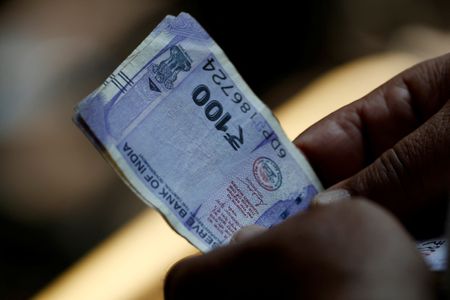By Jaspreet Kalra
MUMBAI (Reuters) -The Indian rupee slid to its lowest in two weeks on Thursday as outflows worsened the hit from a hawkish tilt in Federal Reserve policy, which sent the dollar and U.S. Treasury yields higher.
The rupee closed at 88.6950 against the U.S. dollar, down 0.6% on the day, after touching a two-week low of 88.7375 earlier in the session.
India’s central bank likely stepped in intermittently, via state-run banks, to limit the rupee’s losses but the intervention was not aggressive, traders said.
“A lot of stop losses have been triggered in 88.40 to 88.50 zone leading to fresh highs in USD/INR,” a trader at a state-run bank said.
Asian currencies were down between 0.1% and 0.5% after Federal Reserve Chair Jerome Powell signalled that October’s cut may be the last one for 2025.
Despite the guidance, money markets are currently pricing in a 68% chance of 25 basis point rate reduction in December, according to CME’s FedWatch tool.
“Regardless of the jolt provided by Chair Powell overnight, we think the hurdle for not cutting in December is very high,” analysts at DBS said in a note.
“Cutting rates so far has been easy; decision to cut much more will be fraught with difficulties,” they added.
The dollar index was steady in Asia trading after jumping 0.4% in the previous session. The U.S. 2-year Treasury yield was at 3.598% after rising 9 basis points on Wednesday.
Elsewhere, U.S. President Donald Trump said that the U.S. will lower tariffs on China to 47% from 57% earlier after meeting his Chinese counterpart, Xi Jinping, in South Korea.
(Reporting by Jaspreet Kalra; Editing by Mrigank Dhaniwala)










